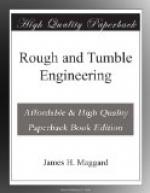Now remove the cap on steam chest, bring your engine to a dead center and give your valve the necessary amount of lead on the steam end. Now, we have already stated that we could not give you the proper amount of lead for an engine. It is presumed that the maker of your engine knew the amount best adapted to this engine, and you can ascertain his idea of this by first allowing, we will say, about 1/16 of an inch. Now bring your engine to the other center, and if the lead at the other end is less than 1/16, then you must conclude that he intended to allow less than 1/16, but should it show more than this, then it is evident that he intended more than I/I16 lead; but in either case you must adjust your valve so as to divide the space, in order to secure the same lead when on either center. In the absence of any better tool to ascertain if the lead is the same, make a tapering wooden wedge of soft wood, turn the engine to a center and force the wedge in the opening made by the valve hard enough to mark the wood; then turn to the next center, and if the wedge enters the same distance, you are correct; if not, adjust till it does, and when you have it set at the proper place you had best mark it by taking a sharp cold chisel and place it so that it will cut into the hub of eccentric and in the shaft; then hit it a smart blow with a hammer. This should be done after you have set the set screws in eccentric down solid on the shaft. Then, at any time should your eccentric slip, you have only to bring it back to the chisel mark and fasten it, and you are ready to go ahead again.
This is for a plain or single eccentric engine. A double or reversible engine, however, is somewhat more difficult to handle in setting the valve. Not that the valve itself is any different from a plain engine, but from the fact that the link may confuse you, and while the link may be in position to run the engine one way you may be endeavoring to set the valve to run it the other way.
The proper way to proceed with this kind of an engine is to bring the reverse lever to a position to run the engine forward, then proceed to set your valve the same as on a plain engine. When you have it at the proper place, tighten just enough to keep from slipping, then bring your reverse lever to the reverse position and bring your engine to the center. If it shows the same lead for the reverse motion you are then ready to tighten your eccentrics securely, and they should be marked as before.
You may imagine that you will have this to do often. Well don’t be scared about it. You may run an engine a long time, and never have to set a valve. I have heard these windy engineers (you have seen them), say that they had to go and set Mr. A’s or Mr. B’s valve, when the facts were, if they did anything, it was simply to bring the eccentrics back to their original position. They happened to know that most all engines are plainly marked at the factory, and all there was to do was to bring




